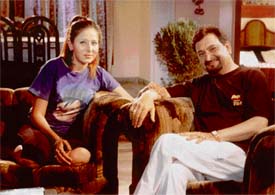|
Shades of politics
Randeep Wadehra

Donny Kapoor with B.B Verma in Rustam-e-Hind. A sequel of the movie is in the offing |
Punjabi
electronic media never ceases to surprise one when it comes to
matters political. Just when viewers were convinced that the
news channels were biased in favour of the ruling party in
Punjab, the Opposition began to make its presence felt on the
small screen, although in a less forceful manner. Then
entertainment channels too joined the act.
Recently one
watched Sukhbir Badal on Punjab Today holding forth on the
omissions and commissions of the Amarinder Singh government. As
if that was not enough, the ETC channel was playing a music
video that described Parkash Singh Badal as Punjab’s best
Chief Minister ever. Now, political cut and thrust adds colour
to election campaigns, but when the channels that seemed out and
out pro-Congress somersaulted in favour of the Akalis one was
left breathless. What was the reason? Political pressure? A quid
pro quo? A change of heart or lucre changing hands? Your guess
is as good as mine.
Punjabi cinema
is trying o catch up with Bollywood in more ways than one. Since
sequels are in vogue, the makers of the Punjabi flick Rustam-e-Hind
too are making its sequel, tentatively titled Siyasat.
You will remember that the movie revolves around the intrigues
and petty politics that bedevil the careers of budding as well
as established wrestlers. Apart from actors like Guggu Gill,
Donny Kapoor, etc, it had famous wrestlers like the Arjuna Award
winner Jagdish Bhola and Parminder Dumcherri in the cast in
order to lend authenticity to the narrative.
Actor-writer-lyricist B. B. Verma points out that a lot of
research on real-life wrestling heroes had been done to make the
film a success. He promises similar inputs for the sequel which
will depict real-life dirty politics that mars our sports
scenario.
There is a lot of frustration
among film artistes based in Chandigarh and Punjab. Although
there are a number of production houses and coordinators based
in the region, only a few are above board in their dealings.
Some hire young artistes promising them rates as high as Rs 4000
per day, but eventually pay them at the rate of Rs 800 or less.
At least one artiste has said that he got nothing for his work.
There is certainly an urgent need to nip this evil in the bud by
checking exploitative tendencies. Moreover it is essential to
have a statutory regulating mechanism that would not only decide
the payment rates but also ensure a fair deal to all concerned.
The region is becoming a hub for film productions. Let an
environment of healthy work ethic be inculcated right when the
industry here is still in its nascent stage.

|